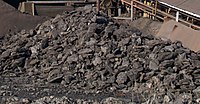
Photo from wikipedia
Abstract Wettability of CO 2 /water/coal systems is a fundamental petro-physical parameter, which governs the fluid flow and distribution in coal seams and thus directly affects CO 2 -storage and… Click to show full abstract
Abstract Wettability of CO 2 /water/coal systems is a fundamental petro-physical parameter, which governs the fluid flow and distribution in coal seams and thus directly affects CO 2 -storage and methane recovery from unmineable coal seams. The recognition of wettability of coal/CO 2 /brine systems help to de-risk CO 2 -storage and enhanced methane recovery projects in coal seams. To understand the factors influencing the wetting characteristics of coals, a detailed examination and characterization of coal surface chemistry is essential and literature data in this context is missing. We thus measured zeta potentials as a function of temperature (298–343 K), brine salinity (0 wt% NaCl–5 wt% NaCl) and salt type (NaCl, CaCl 2 and MgCl 2 ) for coals of low, medium and high ranks. Further, we measured water advancing and receding contact angles as a function of temperature and salinity for the same experimental matrix in order to associate wettability changes to the surface charge at the coal/brine interface. Moreover, coal surfaces were investigated by Fourier transformed infrared (FTIR) spectroscopy and the surface functional groups responsible for a particular wetting behaviour were identified. We found that zeta potential increased with temperature, salinity and cation valency. Both advancing and receding contact angles decreased with temperature, and increased with salinity and cation valency irrespective of the coal rank. Finally the XRD measurements and infrared spectra revealed that the presence of polar surface functional groups (e.g. Si OH and carboxylic acid groups) which is responsible for the hydrophilic behaviour of low rank coals and the absence of these groups in high rank coal is responsible for their hydrophobic behaviour even at lower pressure. The high rank coal seams at high pressure are better for CO 2 storage and methane recovery.
Journal Title: Fuel
Year Published: 2017
Link to full text (if available)
Share on Social Media: Sign Up to like & get
recommendations!